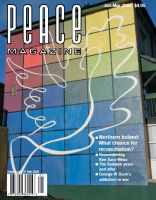
Peace Magazine Jan-Mar 2006, page 27. Some rights reserved.
Search for other articles by Douglas Alton here
By Douglas Roche Toronto: Novalis, 2005
This book distills experience, knowledge and insight to provide a synopsis of the past, an analysis of the present, and a plan for the future. For more than thirty years Douglas Roche has been connected to nuclear weapons related issues. He led the Canadian Delegation to the Third Conference on the Non-Proliferation Treaty (NPT) in 1985 and has monitored related events since then. In 1988 he was Canada's Ambassador for Disarmament to the UN. Further insight came from his career as parliamentarian and senator, from his mentors Bill Epstein and Sir Joseph Rotblat, and Jayantha Dhanapala, the president of the 1995 NPT Review Conference, and from consultations with respected organizations such as Project Ploughshares, the Global Society Institute, Physicians for Global Survival, Pugwash, and the Middle Powers Initiative, with whom he retains close contact.
The book's title could be in the form of a question because it explores the mindset of politicians locked into the concept of nuclear deterrence in the "Second Nuclear Age," offset by the push from civil society for total elimination of nuclear weapons.
The horrors of August 6 and 9, 1945 are recounted from on-site visits to Hiroshima and Nagasaki, and by descriptions of the events by survivors (k nown as hibakusha in Japanese). The efforts for reconciliation and the forward-minded thinking of these victims are linked to the ongoing Mayors for Peace Campaign led by Hiroshima Mayor Akiba.
The history of nuclear weapons, including the Cold War phase of Mutual Assured Destruction, is briefly outlined. The false alarms and catastrophic risks (which included 89 incidents in the period 1950-94 resulting from boredom, stress and human error) document the threat to human survival posed by the existence of these genocidal, omnicidal devices. Nuclear terrorism or attacks on nuclear power plants are also discussed.
Sixty years after Hiroshima we now have a world with 30 000 nuclear weapons. The gravity of the situation is expressed; "The day will arrive when either nuclear weapons are abolished or the world is devastated by a nuclear attack. One or the other will happen. No person, informed of the gravity of the situation, can deny it."
Currently, the 2005 "the NPT Conference merely reflected, rather than mended, the deep rifts over nuclear weapons." The nuclear states continue to rebuild, refine and expand their arsenals. NATO is locked into the hypocrisy of policy that nuclear weapons are "essential" while all NATO states signed on to the "unequivocal undertaking" to eliminate nuclear weapons. The role of the United States is key; the commitment to maintain nuclear weapons, "for as long as nuclear threats remain in the world" undermines nonproliferation. Zooming military expenditure to 1.035 trillion dollars in 2004 saps resources for programs such as the Millennium Development Goals and attempts to promote a life of basic decency for all. "Weapons or water? Guns or bread?"
Other current issues such as Weapons In Space, the impact of the World Court Decision on Nuclear Weapons, and actions of non-governmental organizations are also addressed.
Hope for the future lies in processes to support the NPT such as the Middle Powers Initiative or the Ottawa process. The author is optimistic that civil society will continue to bring forward creative ideas and that moral persuasion will come from religious and humanitarian sources. Actions are encouraged through a list, "Ten Things You Can Do For Nuclear Weapons Abolition." The final chapter encourages discussion by pointing out the need to dispose of five myths that are the core of the arguments used by nuclear weapons proponents. A list of nuclear disarmament websites with brief descriptions of the activities of the organizations ends the work.
This is a well-constructed, clear, concise and readable book. The facts are interspersed with interesting observations and opinions underpinned with enough optimism to balance the grave threats to life on the planet posed by nuclear weapons.
Reviewed by Douglas Alton, a Toronto physician.

Peace Magazine Jan-Mar 2006, page 27. Some rights reserved.
Search for other articles by Douglas Alton here